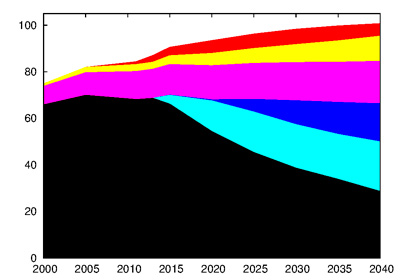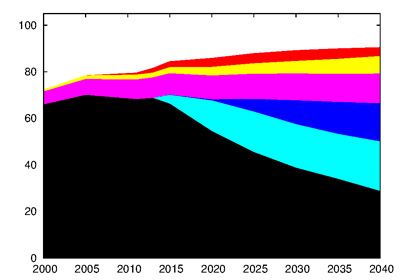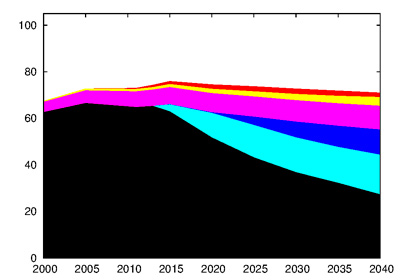Cuba: “Homeland or Death, We Will Grow!”
Erasmo Calzadilla
HAVANA TIMES — During his closing speech at the recently concluded parliamentary session, Raul Castro confirmed that the Cuban economy is slowing down and, in the same sentence, predicted an excellent growth of more than 4 % for the coming new year.
This left me speechless for, regardless of the miraculous efficiency and productivity we could achieve once the “productive forces have been freed”, the global economic arena does not seem to suggest that such a spectacular leap forward is possible.
The World Bank and IMF, institutions that are inherently optimistic, predict a growth of 2.2 % for Latin America and the Caribbean and that of 3.1 % for the world in general. How could Cuba, with a ramshackle infrastructure and allies in a tight corner, grow at a rate comparable to that of the BRICS and the well-positioned emerging world powers?
If all of this sounds crazy or smells like a distraction strategy, it will seem all the more so after listening to the analysis of the most recent report issued by the International Energy Agency (IEA) conducted by researcher Antonio Turiel. Below is a summary of this analysis.
Liquid hydrocarbons (including crude and non-conventional oils) are not replaceable. Without growing supplies of these fuels, no economic growth is possible. Have we at least secured the supply of these fuels? I will present you with the data so you can draw your own conclusions:
According to the 2014 World Energy Outlook report, the volumes of liquid hydrocarbons produced will be as illustrated in the following graph:

Legend:
Conventional Hydrocarbons:
- Black: Crude fields currently being exploited
- Light blue: Fields that are not yet being exploited for economic reasons
- Dark blue: Fields not yet discovered
Non-Conventional Hydrocarbons:
- Purple: Natural gas liquids
- Yellow: Other non-conventional hydrocarbons, excluding shale oil
- Red: Shale oil extracted via fracking
At first sight, it would seem as though our future is guaranteed. The total volume of hydrocarbons produced will not grow exponentially but will do so in a stable and uninterrupted fashion for several decades. So, where’s the problem? Let us take this data apart.

The energy density of non-conventional hydrocarbons is 70 % lower than that of crude oil. Reporting energy production levels in units of volume is therefore misleading. With a series of adjustments and calculations, we can convert the graph above into one showing gross energy output over time in Graph 2.
Gross energy outputs derived from liquid hydrocarbons will remain stagnant for the next two decades. This does not suffice to sustain a system whose principle appears to be “grow or die.” But let us continue.
If we subtract the energy consumed during the production process from the gross energy output, we get the net energy output, which is the amount of energy that is actually available for social use. Graph 3 shows us that the net energy derived from liquid hydrocarbons is already decreasing. We can expect an intensification of conflicts among nations that will in turn affect the world economy.

But let’s not stop here. At the conclusion of his study, Turiel belies a number of stances assumed by the IEA which contradict concepts that are well-known and commonly accepted by geology and other sciences that study these issues. Once the adjustments are made, we get: Graph 4.
We are now in a position to understand why it is so difficult to overcome the current crisis, and why it will continue to be difficult. Only a miracle will avert a vertiginous collapse, a miracle which, according to data offered by the IEA itself, will not come out of fracking (see the red line in Graph 1).

Bearing in mind that other energy sources (gas, coal, nuclear power) are also or will soon be in decline, considering that our allies are treading something of a tightrope, noting that the US blockade has not yet been lifted (and, even if it were lifted tomorrow, its nefarious consequences will not be overcome in a long time) and assuming that the infrastructure of Cuba’s economy is in ruins, we could well ask ourselves the following questions:
What are our experts and political leaders relying on to assure us we are going to grow at breakneck speed? Do they have a card up their sleeves or is this another “white lie” to gain time and seduce investors? Have they discovered a juicy oil well or are they already counting on US dollars?
Every year spent trying to catch up to the world capitalist system, in the hopes it will be reborn, is more time we waste and constitutes an irresponsible and suicidal attitude. To distance ourselves from the beast in free-fall in time is no longer an ideological or moral issue but a simple question of survival.
—–
Notes:
- I use the plural for purely rhetorical reasons: all calculations and graphs were done and prepared by Antonio Turiel






Of course fossil fuels are finite and we have already extracted the easier stuff.
It will become more costly to extract the remaining half or so in the coming years while we are still dependent on fossil fuels.
The exponential growth in AI and technologies that is ensured by Moore’s Law guarantees new sources of clean energy easily within ten years .
Given that a vast majority of the public is unaware of this ongoing and rapidly accelerating development of environmentally safe fuels, it is natural for them to be pessimistic about the future which, absent this guaranteed progress and development. would be dismal indeed.
And…. because so few are aware of this coming rocketing of technologies, few are also aware that robotics and AI, advanced beyond what most are willing to accept as possible, will be what destroys capitalism which will be even more world-changing socially than a switch to an environmentally safe fuel source (s).
This weeks bulletin of advances in AI/robotics from kurzweilai.net contains one small advance but the many responses to this article on what these blossoming technologies will lead to: the death of capitalism is what I found both new and interesting.
http://www.kurzweilai.net/robot-learns-to-use-tools-by-watching-youtube-videosutm_source=KurzweilAI+Weekly+Newsletter&utm_campaign=0ee780091b-UA-946742-1&utm_medium=email&utm_term=0_147a5a48c1-0ee780091b-282060402
Check it out.
You can also subscribe free to this daily or weekly bulletin and keep up with what’s happening
In the 1880’s economist and urban planners were worried about the transportation crisis facing large US cities like New York. The logistics involved in supplying feed for the hundreds of thousands of horses used for transportation was becoming a crises, as was the removal of the tonnes of waste products these beasts produced each day. Gloom and doom was predicted in the looming “peak horse” crisis.
And then the automobile was invented.
Erasmo is correct in his opinion that at some point in the future fossil fuels will be all used up. He is incorrect in predicting when that will be, as we don’t know how much undiscovered fossil fuels there are out there. New developments in the technology of extraction and processing occur every year, lowering the cost of energy production. Cuba could be energy self-sufficient if they made the necessary capital investment in developing modern facilities for extracting and upgrading the heavy bitumen oil they currently pump from the sluggish oil field east of Havana. But so long as the Cuban government criminalizes economic common sense and initiative, it will never happen.
At some point during this century US scientists will develop a reliable & cost-effective method of energy production from the controlled fusion of hydrogen. At that point the world will enter an era of effectively limitless energy supply.
It is true that on it’s current course Cuba faces a Hydrocarbon death spiral. That itself will propel a course correction. Cuba is a net energy consumer versus producer. It’s fortune is not tied to high oil prices other than as to lost charity of Venezuela that is about to enter a special period.
As energy costs drop world wide, consuming nations will benefit. What Cuba needs is investment to become a world trader. The changes in investment laws and new relations with Europe and US all point to this course. How well the country manges a transition to a more complex economy with a mix of private incentive and national control over critical sectors will determine it’s success.
It takes years for structual investments to pay off. But when your starting with a wreck of an economy growth can come fast. Look at China or Vietnam as examples of countries that reoriented their economies. It can be done.
Erasmus has grown up in a land of doom and gloom is a way of life. A land where technical and scientific innovation is practically unheard of. He doesn’t know how to think in other terms.
Without knowing all of the specific optimistic assumptions that Graph 4 dismisses, I can only surmise that this doomsday scenario is based on zero or low energy conservation, zero or low improvement in fuel efficiency and zero or negligible new fuel sources. That is simply unrealistic. Erasmo’s “free-fall” scenario is ridiculous. But more ridiculous is his hope for Cuba’s survival without a major capital infusion from outside of Cuba and a growth scenario that doesn’t include capitalism.